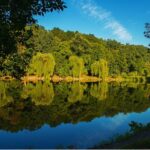Introduction:
Badgers are recognizable mammals that may be found all over the United Kingdom. They are distinguished by their unique black and white striped faces and nocturnal lifestyle. We explore the fascinating world of badgers in the UK in this blog, learning about their habitat, behavior, level of conservation, and more. Come along as we reveal the mysteries behind these mysterious species that have captivated wildlife enthusiasts for decades.
- Heading 1: Badgers in the UK: An Overview
- Heading 2: Habitat and Distribution
- Heading 3: Physical Characteristics of UK Badgers
- Heading 4: Diet and Feeding Habits
- Heading 5: Social Structure and Behavior
- Heading 6: Reproduction and Lifecycle
- Heading 7: Threats and Conservation Status
- Heading 8: Badger Watching in the UK
- Heading 9: Conclusion
Heading 1: Badgers in the UK: An Overview
The United Kingdom is home to three species of badgers: the Eurasian badger, the American badger, and the hog badger. Among these, the Eurasian badger (Meles meles) is the most common and widely distributed. They are native to the British Isles and can be found in various habitats, including woodlands, farmlands, and even urban areas.
Heading 2: Habitat and Distribution
Badgers love locations that contain both open fields and woods. Setts, which they create, are elaborate networks of underground burrows that serve as both their homes and breeding grounds. Setts are made up of a network of tunnels and chambers that offer cover and security.
There are many badger populations in the UK, with Wales and the southwest of England having the highest concentrations. They can also be found in many other places, such as Scotland and Northern Ireland.
Heading 3: Physical Characteristics of UK Badgers
Eurasian badger habitat have stout body and short legs, with males being larger than females. They are characterized by their distinct black and white facial stripes, which are unique to each individual, much like human fingerprints. Their fur is coarse and predominantly gray, providing camouflage in their natural habitats.
Heading 4: Diet and Feeding Habits
Badger diet are omnivorous animals that consume a variety of foods. Earthworms, insects, small animals, bird eggs, fruits, and roots are some of their main dietary sources. They are expert diggers who extract invertebrates from the soil using their powerful claws.
Heading 5: Social Structure and Behavior
Badgers are friendly creatures that live in clans, or extended families. Each clan typically consists of an adult breeding pair and their offspring. They are primarily nocturnal, spending their days sleeping in their setts and venturing out at night to forage for food.
Heading 6: Reproduction and Lifecycle
The breeding season for badgers, which lasts from January to April, is clearly defined. A litter of two to four pups is born by the mother badger after a gestation period of around two months. For the first few weeks, both parents take care of the cubs while they are still in the sett. At roughly eight weeks old, they begin leaving the sett.
Heading 7: Threats and Conservation Status
Although badgers are a beloved species in the UK, they are threatened on several fronts. They face a number of major difficulties, including the loss of their habitat, traffic accidents, and persecution. Bovine tuberculosis (bTB) has also impacted badgers in the UK, which has prompted contentious culling practices in some places.
Heading 8: Badger Watching in the UK
Badger watching has become a popular activity in the UK, allowing nature enthusiasts to observe these fascinating creatures in their natural habitat. Many wildlife reserves and organizations offer guided badger watching experiences, providing visitors with the opportunity to witness badgers foraging and interacting with their clan members.
When participating in a badger watching experience, it’s important to follow ethical guidelines to minimize disturbance to the animals. Qualified guides will lead you to designated viewing areas near setts, where you can quietly observe badgers without causing them stress or altering their behavior. It’s crucial to maintain a respectful distance and avoid using flash photography or making loud noises that could startle the badgers.
During a badger watch, you might witness badgers emerging from their setts at dusk, as they begin their nocturnal activities. These include foraging for food, grooming, playing, and engaging in social interactions within the clan. Badgers are known for their communal grooming behavior, where they engage in mutual grooming sessions to strengthen social bonds and maintain cleanliness.
Even though badgers are primarily nocturnal, they can occasionally be seen during the day, particularly in less disturbed habitats. It’s crucial to remember that the optimum times to observe their natural behaviours are during their overnight activities.
To enhance your chances of spotting badgers, it’s advisable to visit badger watching sites during the spring and summer months when food availability is high, and badgers are more active. Observing badger cubs playing and exploring their surroundings during these seasons can be particularly delightful.
Remember that badger watching is a privilege and should be conducted responsibly. Respect the natural environment, adhere to any guidelines provided by the wildlife reserves or organizations, and ensure that your presence does not disturb or harm the badgers in any way. By promoting ethical and sustainable practices, we can foster a harmonious relationship with these captivating creatures.
Heading 9: Conclusion
Badgers are an essential component of the wildlife in the UK and are particularly beloved by those who appreciate nature. They are a fascinating object of research and observation due to their enigmatic character and distinctive behaviours. We can guarantee the long-term survival of these iconic species by comprehending their habitat, behaviour, and conservation requirements. Grab your binoculars and head to a badger viewing location to start an exciting journey into the fascinating world of badgers in the UK.
In conclusion, badger behavior are amazing animals that are crucial to the ecology. They have captivated people’s attention for millennia due to their unusual look and nocturnal behaviour. We can appreciate and save these iconic species for future generations if we have a thorough understanding of their habitat, behaviour, and conservation status. So let’s embrace the badger world and cooperate to guarantee that they remain a part of the UK’s natural landscape.
This post was created with our nice and easy submission form. Create your post!






Comments
0 comments